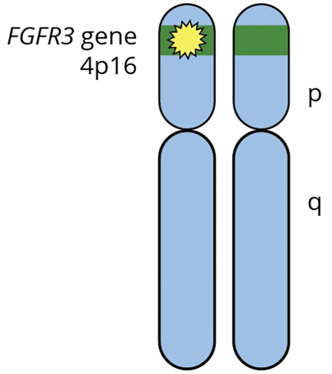
How is dwarfism inherited?
January 15, 2014

A graduate student from India asks:
“My father has dwarfism but my mother is average height. I am of average height too. Is it possible that my child inherited dwarfism from my father (his/her grandfather)?”
People often talk about traits “running in the family.” They mean that if you, your parents, or even your grandparents have a specific trait like blond hair or tall height or whatever, then your child has a chance of inheriting that trait through you. This kind of thing can happen for many but not all traits.
Dwarfism usually (but not always) runs in families too. But it doesn’t always get passed in the same way…scientists have found around 200 different ways so far.
Luckily we don’t have to go over all of them to answer your question. Dwarfism comes in two broad categories—dominant and recessive. We just need to go over each of these.
The most common type of dwarfism is dominant. To end up with this type, you usually have to have a parent with dwarfism. If your dad has this type of dwarfism and you are average height, your kids can’t get his dwarfism from you. It is not in your DNA.
So that leaves the rarer, recessive types of dwarfism. If your dad has this type of dwarfism, then there is a chance you could pass it on to your kids. But they are very unlikely to end up with dwarfism even if they get that DNA from you.

To end up with recessive dwarfism, you need to get it from both mom and dad. This means that both you and your partner need to carry a hidden version of this condition. Given these are very rare, the odds are very much against your partner carrying dwarfism even if you have it.
And even if you both have it, each child still has only a 25% chance of ending up with your father’s dwarfism. As you can see, the odds are pretty slim with this one! But still, it isn’t zero.
For the rest of the answer, I want to go over how each of these types of dwarfism works. And why your kids have such a low risk of getting it from you.
Dominant Dwarfism
So what do these terms “dominant” and “recessive” mean? And why is it possible for your child to inherit dwarfism from your father (if you don’t have it) in one case, but not the other?
Let’s start at the beginning. Here is a list of things that are very important to know when we think about dominant and recessive traits:
- We have two copies of most of our genes.
- Each gene can come in different versions.
- Parents pass just one of their two copies to their child.
- The copy that gets passed is chosen at random.
First let’s see how this applies to dominant traits. As I said earlier, the most common cause of dwarfism is one of these.
Dominant dwarfism is caused by a version of a gene called FGFR3. Like the rest of our genes, this one can come in lots of different versions (number 2 in our list). Most of these versions lead to average height but one causes dwarfism.
Also like most of the rest of our genes, we have two copies of the FGFR3 gene too. One came from mom and the other from dad. You need just one copy of the version that leads to dwarfism to end up with the condition. (No one has two copies because this is lethal.)

This has a couple of important implications for you. First off, if your father’s dwarfism is due to this dominant cause, he must have one copy of this gene that leads to dwarfism and one copy that does not. As your mother is average height, she must not have any copies of this gene version that leads to dwarfism. (If she had one copy, she would also have dwarfism.)
To make things easier to follow, I thought I would draw this out for you. Here is what your mom and dad would like in this case:

As you can see, your dad has one copy of the dwarfism version (orange) and one copy of the average height version (blue). Your mom has two blues and so is of average height.
Your mother must have given you one of her gene copies that does not lead to dwarfism. And since you do not have dwarfism, your father must have also given you his one gene version that doesn’t cause dwarfism. This is probably what happened:

As you can see, you got a blue rectangle from each of your parents. In other words, you must have two copies of the FGFR3 gene that don’t cause dwarfism. In this case, you have no chance of passing on the dwarfism FGFR3 gene to your child. In fact, you don’t have any trace of the gene version that causes dwarfism in your genetics at all! The orange rectangle was left with your dad.
To summarize, you only need one copy of a dominant gene, like the version of FGFR3 that leads to dwarfism, to show a dominant trait. If you don’t show the trait, you must not have any copies of that gene version. And if you don’t have any copies of the gene version, you can’t pass it to your kids!
Now having said this, it is important to mention that sometimes a child ends up with dominant dwarfism even if neither parent has it. Click here to learn how this happens. But if this were to happen to you, it would have nothing to do with your father.
Recessive Dwarfism
Now let’s talk about the less common, recessive type of dwarfism. Unlike the dominant form, it is possible for your child to get the version of these genes that leads to dwarfism from your father even if you don’t have dwarfism. But with this form, one copy isn’t enough.
To end up with recessive dwarfism, your child would have to get a dwarfism gene version from you and your partner. This is not very likely.
If your father’s dwarfism is due to a recessive cause, both copies of one of his genes must lead to dwarfism. This means your dad gave you one of these versions since that is the only version he has!
But since you don’t have dwarfism, your mother must have given you a gene version leading to normal height. You must have one gene copy leading to dwarfism and one gene copy leading to average height. You are a carrier for dwarfism.
I have diagrammed this all out in the image below:

So your dad has two copies of the pink rectangle and your mom has two copies of the blue. You got one from each parent and so have a pink and a blue. You have one gene that can cause dwarfism and on that does not.
Since you have one of each gene, each of your kids has a 50% chance of getting the one that leads to dwarfism and a 50% chance of getting one that leads to average height. But of course, this isn’t enough for the child to end up with dwarfism. He or she needs to get a version that leads to dwarfism from mom too.
So in the recessive case, passing on dwarfism to your child requires teamwork – both parents must give them a copy. Your child can inherit dwarfism from your father only if their other parent also gives them a dwarfism gene copy.
The odds of this happening are pretty small. First off, your partner would have to be a carrier like you. Since this type of dwarfism is rare, then, assuming your partner isn’t too closely related, it is pretty unlikely she would be a carrier too.
And even if she were a carrier, then the two of you would both have to pass the version that leads to dwarfism to the same child. The chances of this happening are 25%. So as you can tell, it is unlikely your child would end up with your father’s dwarfism. Not zero, but very small.
Keep in mind again, though, that the recessive form is pretty rare. Most cases of dwarfism are dominant. And if that is the form your dad has, then you do not have it in your DNA…you cannot pass his dwarfism gene to your kids.

Author: Kimberly McManus
When this answer was published in 2014, Kimberly was a Ph.D. candidate in the Department of Biology, studying population genetics and bioinformatics in Carlos Bustamante's laboratory. Kimberly wrote this answer while participating in the Stanford at The Tech program.
 Skip Navigation
Skip Navigation
